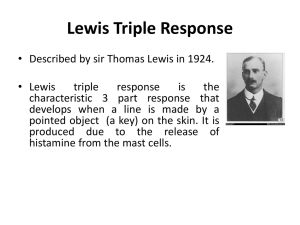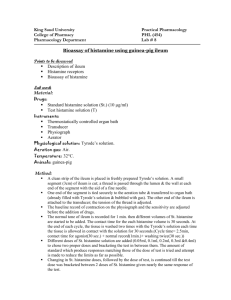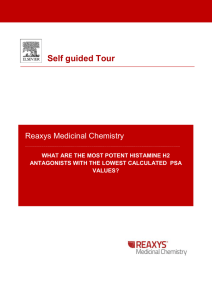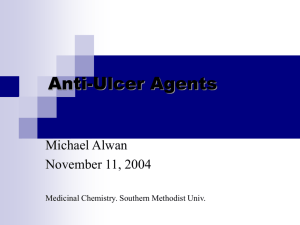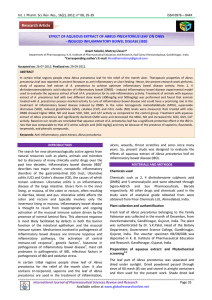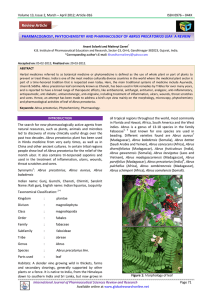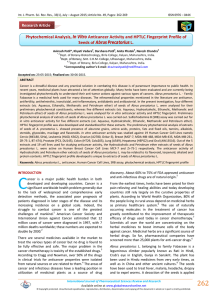Document 13308422
advertisement
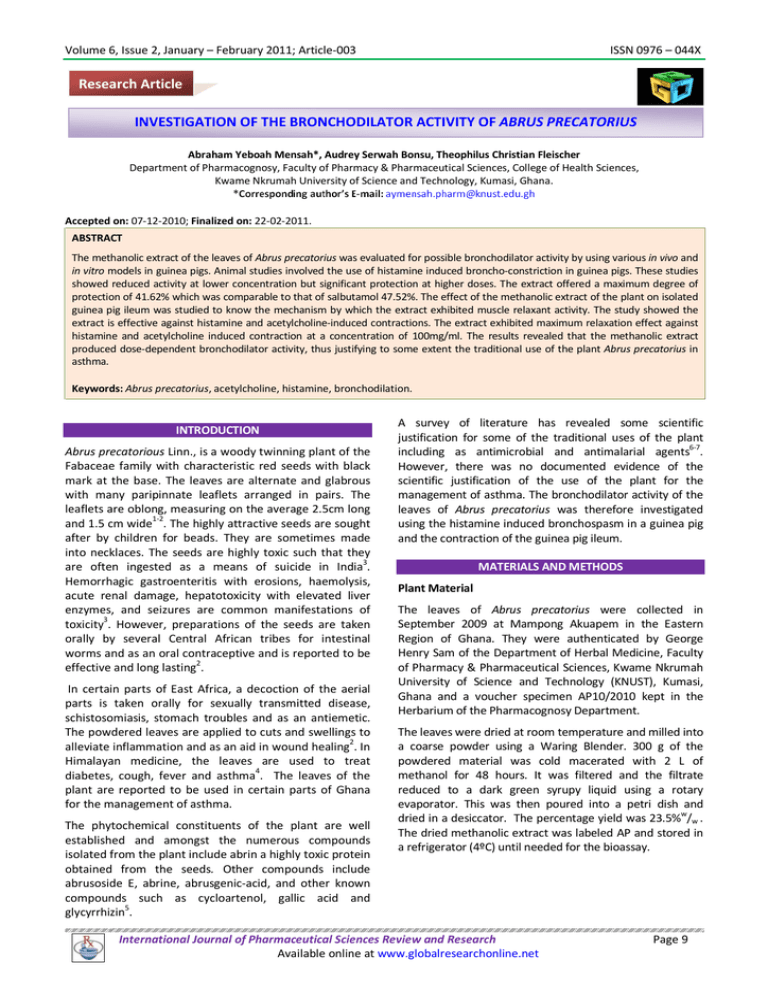
Volume 6, Issue 2, January – February 2011; Article-003 ISSN 0976 – 044X Research Article INVESTIGATION OF THE BRONCHODILATOR ACTIVITY OF ABRUS PRECATORIUS Abraham Yeboah Mensah*, Audrey Serwah Bonsu, Theophilus Christian Fleischer Department of Pharmacognosy, Faculty of Pharmacy & Pharmaceutical Sciences, College of Health Sciences, Kwame Nkrumah University of Science and Technology, Kumasi, Ghana. Accepted on: 07-12-2010; Finalized on: 22-02-2011. ABSTRACT The methanolic extract of the leaves of Abrus precatorius was evaluated for possible bronchodilator activity by using various in vivo and in vitro models in guinea pigs. Animal studies involved the use of histamine induced broncho-constriction in guinea pigs. These studies showed reduced activity at lower concentration but significant protection at higher doses. The extract offered a maximum degree of protection of 41.62% which was comparable to that of salbutamol 47.52%. The effect of the methanolic extract of the plant on isolated guinea pig ileum was studied to know the mechanism by which the extract exhibited muscle relaxant activity. The study showed the extract is effective against histamine and acetylcholine-induced contractions. The extract exhibited maximum relaxation effect against histamine and acetylcholine induced contraction at a concentration of 100mg/ml. The results revealed that the methanolic extract produced dose-dependent bronchodilator activity, thus justifying to some extent the traditional use of the plant Abrus precatorius in asthma. Keywords: Abrus precatorius, acetylcholine, histamine, bronchodilation. INTRODUCTION Abrus precatorious Linn., is a woody twinning plant of the Fabaceae family with characteristic red seeds with black mark at the base. The leaves are alternate and glabrous with many paripinnate leaflets arranged in pairs. The leaflets are oblong, measuring on the average 2.5cm long and 1.5 cm wide1-2. The highly attractive seeds are sought after by children for beads. They are sometimes made into necklaces. The seeds are highly toxic such that they are often ingested as a means of suicide in India3. Hemorrhagic gastroenteritis with erosions, haemolysis, acute renal damage, hepatotoxicity with elevated liver enzymes, and seizures are common manifestations of 3 toxicity . However, preparations of the seeds are taken orally by several Central African tribes for intestinal worms and as an oral contraceptive and is reported to be effective and long lasting2. In certain parts of East Africa, a decoction of the aerial parts is taken orally for sexually transmitted disease, schistosomiasis, stomach troubles and as an antiemetic. The powdered leaves are applied to cuts and swellings to alleviate inflammation and as an aid in wound healing2. In Himalayan medicine, the leaves are used to treat diabetes, cough, fever and asthma4. The leaves of the plant are reported to be used in certain parts of Ghana for the management of asthma. The phytochemical constituents of the plant are well established and amongst the numerous compounds isolated from the plant include abrin a highly toxic protein obtained from the seeds. Other compounds include abrusoside E, abrine, abrusgenic-acid, and other known compounds such as cycloartenol, gallic acid and glycyrrhizin5. A survey of literature has revealed some scientific justification for some of the traditional uses of the plant including as antimicrobial and antimalarial agents6-7. However, there was no documented evidence of the scientific justification of the use of the plant for the management of asthma. The bronchodilator activity of the leaves of Abrus precatorius was therefore investigated using the histamine induced bronchospasm in a guinea pig and the contraction of the guinea pig ileum. MATERIALS AND METHODS Plant Material The leaves of Abrus precatorius were collected in September 2009 at Mampong Akuapem in the Eastern Region of Ghana. They were authenticated by George Henry Sam of the Department of Herbal Medicine, Faculty of Pharmacy & Pharmaceutical Sciences, Kwame Nkrumah University of Science and Technology (KNUST), Kumasi, Ghana and a voucher specimen AP10/2010 kept in the Herbarium of the Pharmacognosy Department. The leaves were dried at room temperature and milled into a coarse powder using a Waring Blender. 300 g of the powdered material was cold macerated with 2 L of methanol for 48 hours. It was filtered and the filtrate reduced to a dark green syrupy liquid using a rotary evaporator. This was then poured into a petri dish and dried in a desiccator. The percentage yield was 23.5%w/w . The dried methanolic extract was labeled AP and stored in a refrigerator (4ºC) until needed for the bioassay. International Journal of Pharmaceutical Sciences Review and Research Available online at www.globalresearchonline.net Page 9 Volume 6, Issue 2, January – February 2011; Article-003 Animal grouping and extract administration Twenty guinea pigs of either sex weighing between 250 g and 600 g were purchased from the Centre for Scientific Research into Plant Medicine, Mampong-Akuapem, Ghana and maintained in the Animal House of the Department of Pharmacology, KNUST, Kumasi They were housed in stainless steel cages (34×57×18 cm3) at a population density of 5 guinea pigs per cage in a temperature regulated environment (26-29°C) with a 12 h light-dark cycle. Food and water were available ad libitum until a day before the experiment. Daily maintenance of the cages was conducted during the first quarter of the light cycle. Group sample sizes of five were utilized throughout the study. The guinea pig handling and experimental protocol were in accordance with the Pharmacology Department institutional animal care and use method approved by the Ethical Review Committee of the College of Health Sciences, KNUST. Determination of Pre-convulsive Time (PCT) In this assay guinea pigs were subjected to histamine challenge and the time taken in seconds, to show the first signs of respiratory distress was observed by increased rippling spasm. This is known as the Pre-convulsive time (PCT)8. The apparatus for the determination of PCT consist of two main components. A rectangular Perspex glass, with a capacity of about 30 cubic inches. It has a door through which the animal is introduced and taken out of the chamber, air inlet and outlet tubes and a histamine inlet tube as shown in figure 1. ISSN 0976 – 044X glass, greased with paraffin wax to ensure effective closing of the door. A stop clock was used to record the PCT. The experiments were carried out early in the morning when the animals had not eaten, to facilitate easy administration and effective absorption of the drugs. The twenty guinea pigs were divided into four groups, A, B, C and D. The five animals in each group were subjected to the histamine challenge. The electric source was switched on for two minutes to saturate the chamber with the challenging histamine solution (1% w/v). The animals were then individually introduced into the chamber, the door closed and the stop clock started simultaneously while the spraying continued. Each animal was then observed for the first signs of respiratory distress by looking at the sides of the animal for increased rippling spasms or sometimes convulsive coughs. The stop clock was stopped, the nebulizer switched off and the animal taken out of the chamber quickly. The animals were sometimes fanned and more so if any of them convulsed, to facilitate aeration and improved breathing. The period between the time each animal was introduced into the chamber and the time it showed the first signs of respiratory distress was noted and recorded as the PCT. This was repeated for all the animals in each group. The experiment was repeated on three occasions and in each case, a period of 3 days was allowed between the subsequent and previous experiments. In the first experiment designated as control, no drug was administered, only the challenging drug (histamine 1% w/v) was used. In the second and third subsequent experiments, the AP and standard bronchodilator drug used as positive control were administered orally to the animals of different groups. Group A received 30 mg/kg of AP, group B 100 mg/kg of AP, group C 300 mg/kg of AP and group D, the standard bronchodilator salbutamol (Kinapharma, Ghana) at a concentration of 0.2 mg/kg body weight (which is the normal dose for humans). The drugs were administered 30 minutes before the PCTs were determined. The PCTs were used again to determine the degree of protection each drug gave to the animals as compared to the positive control of salbutamol. Degree of protection of the guinea pigs by the AP1 and salbutamol Figure 1: Set up for the determination of the preconvlusive time (PCT). The second component is a Wright nebulizer connected to an electric source. Closely attached to the nebulizer is a small bottle that contains freshly prepared 1% w/v histamine phosphate (Sigma, UK) solution that is connected to the chamber by the histamine inlet tube. On switching on the electric source, the nebulizer sprays the histamine into the glass chamber in the form of fine aerosol-like spray. The Perspex glass was well cleaned to ensure transparency and the door and the edges of the Using the difference between the pre-convulsive time of the test drug (AP and salbutamol) and that of the control, the degrees of protection were calculated. As shown below by the formula Degree of Protection = (1-C/T) ×100% where C = PCT for the control and T = PCT for the test drug. The degree of protection offered by each of the test drugs were calculated using the above formula. Evaluation of the relaxation effect of Abrus precatorius extract on guinea pig ileum An overnight fasted guinea pig was sacrificed according to the College’s ethics guidelines and the ileum was mounted International Journal of Pharmaceutical Sciences Review and Research Available online at www.globalresearchonline.net Page 10 Volume 6, Issue 2, January – February 2011; Article-003 in an organ bath containing tyrode solution. The tyrode solution was continuously aerated and maintained at 37˚C. The tissue was allowed to equilibrate for 30 minutes under a load of 500 mg. Doses of Histamine (20 µg/ml) were introduced for a contact time of 30 seconds and the response evoked by each histamine was recorded by 5 minute time cycle. After obtaining a dose response curve of histamine on the ileum, the dose which gave the highest response was selected and was repeated with graded doses of the AP of different concentrations (1 mg/ml, 10 mg/ml and 100 mg/ml) to determine if the extract could inhibit the highest response of histamine. This was done until the dose which gave complete inhibition of histamine response i. e. relaxation of the contraction induced by the histamine was observed as shown in Figure 2. A positive control experiment was conducted using 1 mg/ml mepyramine (Sigma, UK), a known antihistamine. Figure 2: Effects of A. precatorius extract (1-100 mg/ml) on histamine induced contractions. A similar experimental procedure was repeated using acetylcholine (Sigma, UK) instead of histamine to obtain a dose response curve. Graded doses of the extract were used once again to investigate if the extract could also inhibit acetylcholine induced contraction. The results are presented in figure 3. A positive control experiment was performed using atropine (Sigma, UK), a known anticholinergic drug. ISSN 0976 – 044X RESULTS AND DISCUSSION In vivo bronchodilator activity Histamine induced broncho-constriction is the traditional immunological model of antigen induced airway obstruction. Histamine when inhaled causes hypoxia and leads to convulsion in the guinea pigs and causes very strong smooth muscle contraction, profound hypotension, and capillary dilation in the cardiovascular system. A prominent effect caused by histamine is severe bronchoconstriction in the guinea pigs that causes asphyxia and death9. Bronchodilators can delay the occurrence of these symptoms. In the in vivo assay, the extract of concentrations 30, 100 and 300 mg/kg body weight were given orally, 30 minutes before the histamine challenge and the pre-convulsive time (PCT) calculated. The present findings show that methanolic extract of Abrus precatorius leaves prolonged the PCT in the guinea pigs following histamine induced bronchospasm. Figure 4 shows the degree of protection offered by each concentration of Abrus precatorius extract (AP) and the salbutamol (SAL). Each dose of AP protected the animal to some extent from the histamine induced broncho-constriction. The range of degree of protection was between 7.74% (for a dose of 30 mg/kg) and 41.62 % (for a dose of 300 mg/kg). The maximum percentage protection calculated was 41.62% and was obtained at 300 mg/kg dose of the AP. The broncho-relaxation effect increased with increasing dose of the extract as shown in the Figure 4. The positive control drug, salbutamol gave the maximum protection of 47.52%. Salbutamol is a well known β-2-receptor agonist with bronchodilator activity and is routinely used in the management of conditions of broncho-constriction as occurs in asthma10. The results suggest that the Abrus precatorius leaf extract may have bronchodilator activity justifying the traditional uses of the plant in the management of asthma. Figure 4: Graph showing the degree of protection offered by the extracts of Abrus precatorius against histamine induced broncho-constriction. Guinea pig ileum assay Figure 3: Effects of A. precatorius extract (1-100 mg/ml) on acetylcholine induced contractions. Different agonists such as histamine and acetylcholine are known for their ability to induce contraction in some tissues including the guinea pig ileum. In the isolated guinea pig ileum, there are histaminic and cholinergic International Journal of Pharmaceutical Sciences Review and Research Available online at www.globalresearchonline.net Page 11 Volume 6, Issue 2, January – February 2011; Article-003 ISSN 0976 – 044X 9 receptors . Hence a decrease or inhibition of the contractions induced by histamine and or acetylcholine in the presence of the leaf extract of Abrus precatorius, as shown in Figure 2, is suggestive of possible anti-histaminic or anti-cholinergic activity. The guinea pig ileum was used for screening of antihistaminic and anti-cholinergic activities. This is because the presence of histamine H1 sensitive excitatory receptors and acetylcholine muscarinic receptors in the airway smooth muscle of man and animals have been established11. The stimulation of H1 receptors produced graded dose related contractions, and from the result, it was observed that the extract of Abrus precatorius (100mg/ml) significantly inhibited the histamine induced contractions on the guinea pig ileum preparation (Figure 2) indicating its H1 receptor antagonistic activity and supports the bronchodilator properties of the plant. The stimulation of the vagus nerve releases acetylcholine, which binds to specific receptors on the smooth muscle within the bronchial walls and thus constricts the airways. Cholinergic stimulation causes broncho-constriction through airway smooth muscle contraction11. Thus stimulation of cholinergic receptors produced graded dose related contractions and in this case, the extract of Abrus precatorius (100 mg/ml) significantly inhibited the acetylcholine induced contractions on the guinea pig ileum preparation (Figure 3), indicating its cholinergic receptor antagonist activity and supports the anti-asthmatic properties of the plant. Asthma is an inflammatory disease of the lungs characterized by increased infiltration of leukocytes, especially eosinophils, into the airways, and reduced respiratory function and that the inflammation induces broncho-constriction, increase airways hypersensitivity and mucus production12. It is important to emphasize that the mechanism involved in asthma condition is more complex than the model used in our assay. Nevertheless, the bioassay models used in these experiments give a good insight into the justification of the traditional use of the plant for the management of asthma. It is instructive that the neuromuscular effects of the crude extracts of the leaves of Abrus precatorius have been investigated using isolated toad rectus abdominis and rat phrenic nerve-diaphragm muscle preparations as well as young chicks13. In their study, the ethanol extract of the leaves inhibited acetylcholine-induced contractions of both toad rectus abdominis and rat phrenic nervediaphragm muscle preparations. The extract also caused flaccid paralysis when injected intravenously into young chicks. Their findings in a way confirm the adrenergic activities of the plant as observed in our study even when different animals and tissues were used. CONCLUSION From the results obtained, it can be deduced that the methanolic extract of the leaves of Abrus precatorius has broncho-dilatory effect and its use traditionally in the management of asthma is justified. The results of the study demonstrate that the possible mechanisms of action may be anti-histaminic, anti-cholinergic and adrenergic effects. Acknowledgements: The authors appreciate the technical support offered by Mr. Kwadwo Kakraba and Mr. Edmond Ekuadzi both of the Pharmacognosy Department KNUST and Mr. Thomas Ansah of the Pharmacology Department, KNUST. We are also grateful to Mr Sarkodie of the College of Architecture and Planning, KNUST for sharing his traditional knowledge of the plant with us. REFERENCES 1. Mshana NR, Abbiw DK, Addae-Mensah I, Adjanouhoun E, Ahyi MRA, Ekpere JA, Enow-Orock EG, Gbile ZO, Noamesi GK, Odei MA, Odunlami H, Oteng- Yeboah AA, Sarpong K, Sofowora A. and Tackie AN. Traditional Medicine and Pharmacopoeia Contribution to the Revision of Ethnobotanical and Floristic Studies in Ghana. Scientific, Technical and Research Commission of the OAU (OAU/STRC), Lagos, Nigeria 2000 2. Ivan AR, Medicinal plants of the world Vol.1 Humana Press, 2003, 492-495. 3. Subrahmanyan D, Mathew J, Raj M, An unusual manifestation of Abrus precatorius poisoning: a report of two cases. Clinical Toxicology 4(2), 2008, 173-175. 4. Tun UK, Than UP, The family Fabaceae Myanmar Medicinal Plant Database 2006 www.tuninst.net/MyanMedPlants/TIL/famF/Fabac eae.htmv accessed in February 2011. 5. Kennelly EJ, Lining C, Nam-Cheol Kim and Kinghorn AD. ‘Abrusoside E, a further sweet-tasting cycloartane glycoside from the leaves of Abrus precatorius’, Journal of Phytochemistry,41 (5), 1996, 1381-1383. 6. Adelowotan O, Aibinu I, Adenipekun E, Odugbemi T. The in-vitro antimicrobial activity of Abrus precatorius (L) fabaceae extract on some clinical pathogens. Nigerian Postgraduate Medical Journal. 15(1), 2008, 32-7. 7. Bagavan A, Rahuman AA, Kaushik NK, Sahal D. In vitro antimalarial activity of medicinal plant extracts against Plasmodium falciparum. Parasitology Research.108(1), 2011, 15-22. 8. Kortoh-Mortty RK, Ansah-Asamoah, Some Pharmacological effects of Desmodium adscends on the contracted trachea In vitro and In vivo and spontaneous beating right atrium of the guinea pig, Journal of Science and Technology,15, 1995, 60- 63. International Journal of Pharmaceutical Sciences Review and Research Available online at www.globalresearchonline.net Page 12 Volume 6, Issue 2, January – February 2011; Article-003 9. Goodman LS, Gilman A, Pharmaceutical Basis of Therapeutics, 10th ed., Macmillan Press London, 2001. 10. Wingard LB, Larner J, Schwartz A,. Human pharmacology, Molecular to Clinical, Mosby Year Book. 767-774, 1991. 11. Busse, WW, Calhoun WJ, Sedgwick JD, Mechanisms of airway inflammation in asthma. American Revised Respiratory Disease 147,1993, S20-S24. ISSN 0976 – 044X 12. Djukanovic R, Roche WR, Wilson JW, Beasley CR, Twentyman OP, Howarth RH. Mucosal inflammation in asthma. The American Review of Respiratory Disease, (142) 1990, 434-457. 13. Wambebe C, Amosun S, Some neuromuscular effects of the crude extracts of the leaves of Abrus precatorius, Journal of Ethnopharmacology 11, 1984, 49-58. ***************** International Journal of Pharmaceutical Sciences Review and Research Available online at www.globalresearchonline.net Page 13
